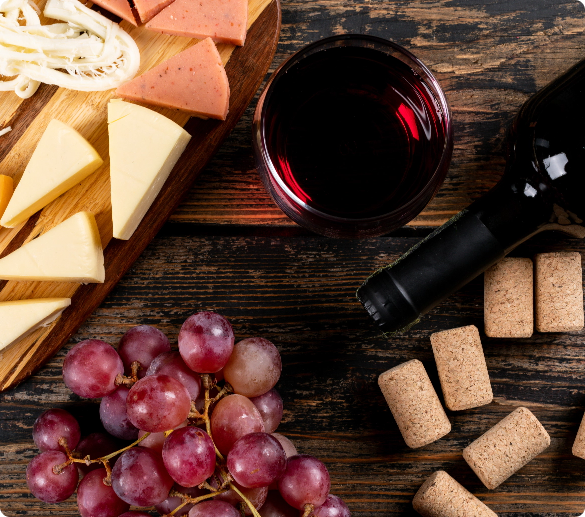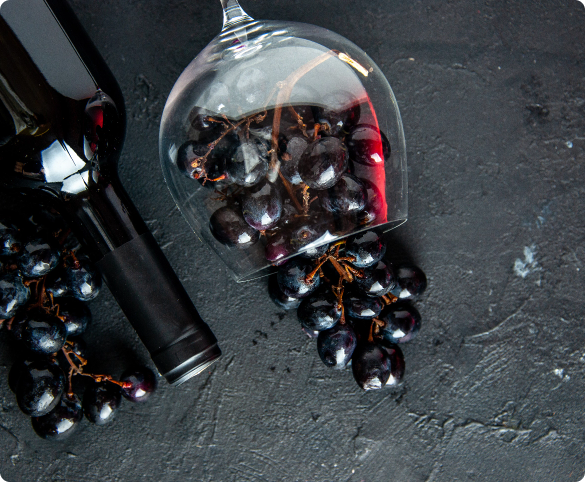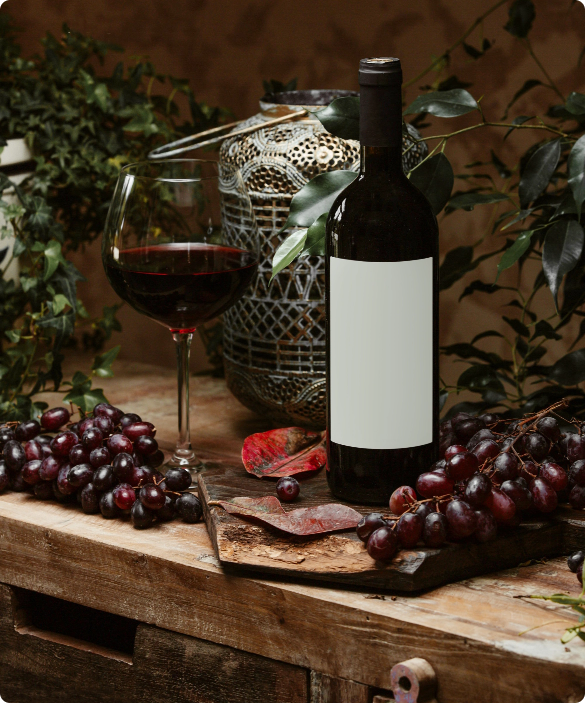WINEMAKING PROCEDURE
When starting your winemaking, ensure that your primary fermenter is capable of holding at least 30 liters (7.9 US gallons) of volume. Pre–mark the primary fermenter at 23 liters (6 US gallons) by filling your 23 liter (6 US gallons) carboy with cool water and then pouring or racking the water into the primary. Draw a line with a permanent marker on the fermenter at the water level and this will be your fill level (below). Discard water and begin.
Clean and sanitize primary fermenter and lid, spoon, thermometer, hydrometer, test jar, and wine thief. Rinse thoroughly.
STEP 1
PRIMARY FERMENTATION
1. Add 2 liters (½ gallon) of hot water to the bottom of your sanitized primary fermenter. Stir the water vigorously and slowly sprinkle the contents of package(s) #2 (bentonite) onto the surface. Stir for 30 seconds to ensure even dispersal and to break up any clumps.
2. Secure the neck of the bag into the collar on the top of the box, carefully remove the cap, and pour the contents into the primary fermenter with the bentonite solution. Add 2 liters (1/2 gallon) of warm water to the bag to rinse out any remaining juice and add it to the fermenter.
3. Top up fermenter to the 23-liter (6 US–gallon) mark with room temperature water and stir vigorously for 30 seconds. NOTE: Making the kit to a full 23 liters (6 US gallons) is crucial to the functioning of the fining agents and stability of the finished wine. If you make it to any other volume, it will not turn out correctly, and any problems you may experience may not be solvable.
4. Draw a sample of the juice and use your hydrometer and test jar to check the specific gravity. It should read between 1.080–1.097, depending on the wine type.


5. If your winemaking kit contains oak, tear open the package(s) and sprinkle them into the primary fermenter now. If your kit has more than one package of oak, add them all. Stir them under the surface of the liquid.
6. Ensure that the temperature of the juice is between 22°–24°C (72°–75°F). Do not proceed unless the juice is in this range.
7. ADD YOUR YEAST NOW. Open the yeast package and sprinkle contents onto the surface of the juice. Do not rehydrate the yeast. Do not stir it in. It will activate on its own.
8. Cover the primary fermenter and place in a location with a temperature of 22°–24°C (72°–75°F). If your primary fermenter uses an airlock, insert it now. Remember to fill airlock halfway with water. Fermentation should start within 24–48 hours. In 5-7 days proceed to the next step. Clean and sanitize siphon rod and hose, hydrometer and test jar, wine thief, 23–liter (6 US–gallon) carboy, bung and airlock. Rinse well. After 5–7 days draw a sample of the juice and use your hydrometer and test jar to check the specific gravity. It should be 1.010 or less. You must rack (transfer) the wine into a 23–liter (6 US–gallon) carboy at this time.
NOTE: The lower the fermenting temperature, the longer it will take to reach this stage. If your gravity is not at or below this level, wait, testing the gravity each day, until it is.
STEP 2
SECONDARY FERMENTATION

Clean and sanitize siphon rod and hose, hydrometer and test jar, winethief, 23–liter (6 US–gallon) carboy, bung and airlock. Rinse well.
After 5–7 days draw a sample of the juice and use your hydrometer and test jar to check the specific gravity. It should be 1.010 or less. You must rack (transfer) the wine into a 23–liter (6 US–gallon) carboy at this time.
NOTE: The lower the fermenting temperature, the longer it will take to reach this stage. If your gravity is not at or below this level, wait, testing the gravity each day, until it is.
1. Place the primary fermenter up at least 1 meter (3 feet) onto a sturdy table.
2. Carefully siphon wine into a clean, sanitized 23-liter (6 US-gallon) carboy. Leave the thickest sediment behind, but make sure you transfer most of the liquid. This will leave a space at the top of the carboy of approximately one liter (one US quart) in volume.
Do not top up (add water) to the carboy. This space is required for stirring and additions during stabilizing.
STEP 3
STABILIZING AND CLEARING
Before proceeding, clean and sanitize hydrometer, test jar, winemaking thief and spoon. Rinse well. After 10 days, check your specific gravity. It should be 0.996 or less. If it is higher than 0.996 wait 2 days and measure again— remember, temperatures below 22°–24°C (72°–75°F) will extend fermentation time.
For Mezza Luna wines: These wines will not ferment below 0.998. This is normal. Once the gravity of these wines reaches 0.998 you can proceed with fining and stabilizing.
If you do not verify the gravity reading, your wine may not clear properly!
NOTE: Do NOT rack the wine before stabilizing and fining. This kit requires that you stir the sediment back into suspension. Racking the wine off the sediment prior to fining may permanently prevent clearing.
Please be sure to stir all of the sediment up from the bottom. The wine needs extremely vigorous stirring during this stage. Without hard stirring, trapped gas in the wine will prevent clearing. At each stirring, whip the wine hard. Drill-mounted stirring devices (see your retailer) can ensure efficient degassing.


1. Dissolve contents of package(s) #3 (metabisulphite) and package(s) #4 (sorbate) in 125 ml (½ cup) of cool water. Add to carboy and stir vigorously for 2 minutes to disperse the stabilizers and drive off CO2. Be sure to stir up yeast sediment from the bottom, and stir hard enough to agitate gas out of the wine. If your winemaking kit came with any F-Packs, follow the special instructions below. If it does not have an F-Pack, proceed to Step 2.
SPECIAL INSTRUCTIONS FOR F-PACK KITS ONLY
Remove 500 ml (2 cups) of wine from the carboy to make room for the contents of the pack(s). Reserve this wine for topping up the carboy (Step 3). Shake the F–pack bag(s), carefully remove the cap, and gently pour contents into the carboy. Stir vigorously for 60 seconds. Your gravity will now read between 0.998 and 1.007 depending on the style of kit. Proceed to Step 2.
2. Shake contents of package(s) #5 (Chitosan or isinglass clarifier). Carefully cut open the corner of the pouch(es) and pour contents into carboy. Stir vigorously for another 2 minutes to degas the wine. If you do not degas the wine completely, it will not clear.
3. For F-pack kits, please return any reserved wine to the carboy now. For all other kits, do not top up or add any extra water. Topping up will change the character of your wine.
4. Fill airlock halfway with water and reattach bung and airlock to carboy.
5. Leave carboy in your fermentation area at the temperature of 22°–24°C (72°–75°F) for 14 days to clear. After 14 days, your wine should be ready for Bottling (Step 4).
STEP 4
BOTTLING

1. Siphon your wine into clean, sanitized bottles and seal with a good quality cork. Be sure to leave two finger–widths of space between the bottom of the cork and the level of the wine in each bottle.
2. Leave bottles upright for 3 days before laying them on their sides, to allow corks to seal. Store bottles in a dark, cool, temperature-stable place.
Try to wait at least one month before you taste your wine — it will improve even more after three to six months!
Questions on winemaking? Comments on winemaking? Contact us at info@brewyourownbrew.com (888-322-5049) or info@winexpert.com
